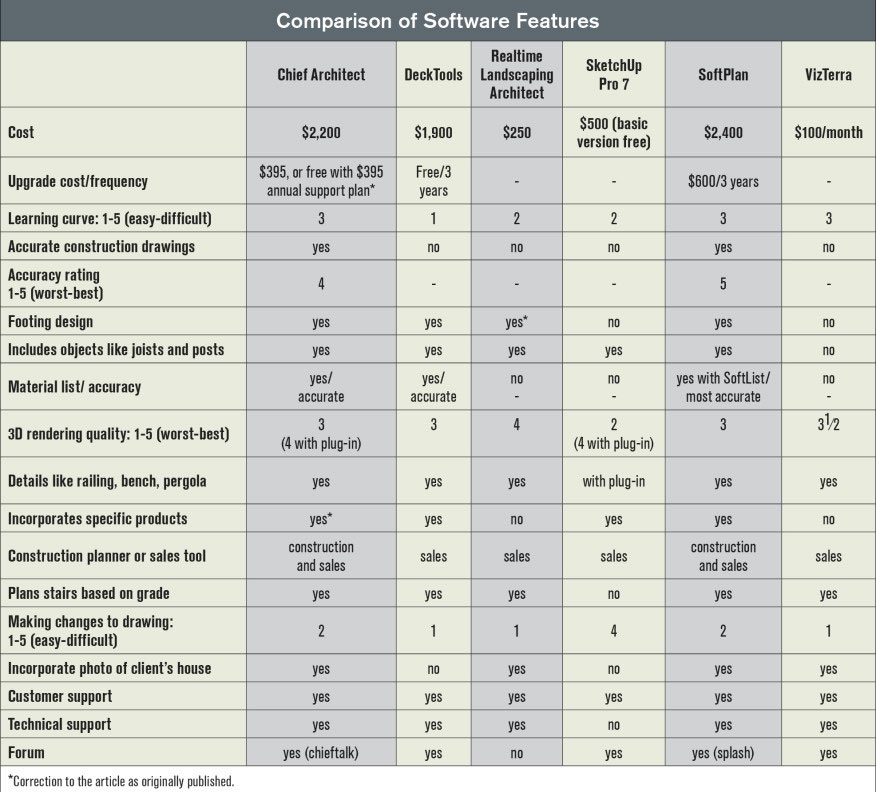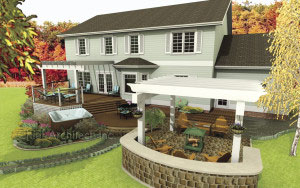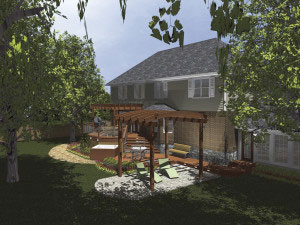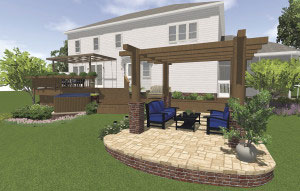Realtime Landscaping Architect 2023 was designed from the ground up to be easy to use no matter how complex your design is. There’s no need for expensive classes or training.
Use the intuitive deck tools to create decks of any size, shape, and style. Create a deck design in as few as five clicks. Then customize your deck creation until you find the perfect combination of style and function. Select one of our 14 predefined styles to instantly visualize a new look, or create a custom design style of your own that can be saved and used over and over. Help clients visualize your design ideas with the decking and railing products you use.
Creating a deck is as simple as drawing its outline. The boards, support posts, and railing are added automatically. Multi-story decks, curved decking and railing, and decks with holes for hot tubs are all supported. Decking materials include composite, cellular PVC, stone and vinyl, as well as painted, stained, and natural wood.
Editor’s note: Nearly a full year ago, PDB asked makers of popular construction software for copies of their products to review, and six agreed to participate. Four deck builders, the authors of this article, then learned how to use the programs. Their computer savvy ranged from expert to still drawing plans with pencil and paper. I can’t thank them enough for the huge amount of time and effort they put into this article.

A common weak spot for all the software was the framing drawings. While most do an adequate job automatically filling in the framing, they tend to hiccough when the deck isn’t a simple rectangle. In the drawing at top, the deck bumps out, but the software continued the main beam straight. The drawing on the bottom shows the manual changes that were needed.
How do the various CAD programs out there stack up for deck builders? That’s the question we set out to answer. Whether you’re dissatisfied with your current program or you’re making your first foray into CAD, buying a new program means investing a chunk of time and money; hopefully this article will help you spend both wisely.
No single CAD program is best for all deck builders. The first step to finding the right one for you is deciding what you want it to do. Do you want a sales tool that produces renderings to show your customers? Or a design tool capable of producing detailed drawings you can give to the building department and your crews? Do you want a cost-estimating feature? Do you want to design more than decks — say, porches or additions?
You also have to think about how hard you’re willing to work to learn the program and how much support you’ll require. And finally, as with any tool purchase, you need to consider your budget.
What the Programs Do
Each of the programs we tested — Chief Architect, DeckTools, Realtime Landscaping Architect, SketchUp, SoftPlan, and VizTerra — has good points.
All are capable of producing renderings you can e-mail your clients as a sales tool, though SketchUp requires complementary software to do this well (accompanying each program’s review, except for SketchUp, is a rendering generated by that program; see pages 28 to 32). With some of the programs, you can import a photo of the clients’ house and build a rendering against it, while with others you have to draw the house. Most have modular parts you can simply drop into place — from joists and beams to landscaping elements like trees, shrubs, and walkways.
If you’re serious about doing design work on a computer, be serious about your computer. RAM is the memory largely responsible for the speed of image-intensive software like these CAD programs. Make sure you have enough installed (8GB is a good amount). A dedicated video card is a good idea, as well. Machines with less RAM or without a dedicated video card will still run these programs — they just won’t do it as well.
With all the programs except SketchUp, you can create construction drawings for simple decks by drawing a perimeter and having the program automatically fill it in with elements like joists and beams. The quality of this feature varies, though. We also found that when the deck had angles or offsets, the automatically placed framing elements didn’t always end up where we would have placed them. For example, most of the programs don’t adjust the location of the main beam if the deck bumps out — you have to move it manually (see drawings, facing page).
At complex framing design, Chief Architect is the best of the bunch. With most of the others, we found it faster to “draw” the members and place them with a mouse click. In SketchUp, everything has to be drawn manually, although over time you can build a library of parts you’ve drawn.
None of these programs handle load calculations for beams and joists. One program we use to fill in this blank is StruCalc (strucalc.com). It quickly calculates footings and structural members such as beams, joists, rafters, and so on. The cost is $500, although StruCalc Lite, which doesn’t do footings (and some other things that aren’t crucial to deck builders), is available for $150. It’s important to remember the adage “garbage in, garbage out” with programs like this; be sure you understand what input is needed. When in doubt, consult an engineer.
Some programs include pre-built modules that depict specific manufacturers’ products. While this sounds good in theory, in practice we didn’t find it all that valuable — on a computer screen, one manufacturer’s brown synthetic decking looks pretty much like any other manufacturer’s brown synthetic decking.

How They’re Marketed
Two of the programs, Chief Architect and SoftPlan, let you design everything that goes into and around a house. Select the deck button, draw in the perimeter, and both programs will infill the posts, beams, joists, and decking to provide a complete set of construction documents plus a 3D rendering.
Two others, Realtime Landscaping Architect and VizTerra, are meant mainly for landscape designers. They show the home’s outside, including the roof and everything that goes into the landscape, but nothing inside the home. Both employ a deck design module to create 2D plan views and 3D renderings.
Only one of the programs we tested is sold as a deck design program — DeckTools. It shows the outside walls of a house and its door and windows, but not the roof. It designs decks in a top view, left- and right-side views, and a 3D view, but doesn’t have much in the way of landscaping options.
Finally, SketchUp Pro, a souped-up version of Google’s free online 3D modeling program, lets you draw everything in 3D but has no deck module. Every feature has to be drawn individually.
The cost of these programs ranges from free for basic SketchUp (which we didn’t test) to a few hundred bucks to several thousand. Of course, the more sophisticated programs are more costly, but there was a happy surprise: Our overall favorite program for renderings was Realtime Landscaping Architect, and its cost was on the low end.
Like costs, the difficulty varied. The time required to learn the programs can range from a day to years. Most can be mastered within a few months.
Most manufacturers provide a free trial period, although some have limitations, like not allowing you to print or save a document. DeckTools has no trial version, but you can return the program within two months if you’re not happy with it. VizTerra is leased on a monthly basis.
We recommend downloading the one that interests you. If you like it and it does what you are looking for, stick with it. Any software is only as good what you put into it. It takes time to build up a library of parts, settings, and preferences.
The authors are all professional deck builders. Jerry Bannister hails from Seattle, Clemens Jellema from Owings, Md., and Kim Katwijk and Jason Russell from Tacoma, Wash.

Chief Architect
Chief Architect
chiefarchitect.com
Cost: $2,200
Chief Architect is a comprehensive program geared to residential and light construction and is one of the most popular programs for builders on the market. If you only do decks it might be more than you need, but if you also do additions, porches, and interior work, this software is hard to beat for the money. Chief Architect is better at 3D modeling and is a little more user-friendly than its main competitor, SoftPlan, in our opinion.
For generating framing drawings automatically, it’s the best of the programs we tested. We usually needed to make some changes, but they were easily done. Its out-of-the-box 3D renderings weren’t the best. Used with Raytracer, a free download from Pov-Ray (povray.org), it gives a decent rendering. (The manufacturer also offers its own raytracing engine, Chief Architect Raytracer.)*
Overall this is an impressive program. Chief Architect has a great community of users, and you can ask them for help or just learn by reading the forums. There are also tons of training videos and seminars online. You won’t be disappointed.
*Correction to the article as originally published.

DeckTools
Simpson Strong-Tie
strongtie.com/decktools
Cost: $1,900
DeckTools is designed specifically for deck builders. It’s easy to learn and will quickly draw a deck with up to 1⁄16-inch precision. Making changes or altering the design is a breeze. You can view and design in all four views or just one.
Simpson advertises DeckTools’ ability to provide realistic 3D renderings of specific decking, railing, and hardware from several manufacturers. It displays the actual grain pattern on decking boards, as well as particular railing profiles.
It has a number of other features. The custom-railing designer is great. Create any railing imaginable and save it for future designs. A few clicks can customize DeckTools’ prebuilt railing styles, or you can use your own. You can also create custom objects with the design tools and build your own library. The program has a limited library of furniture but a good selection of windows and doors. Modifying the automatic framing isn’t hard but can be time consuming if you need to make a lot of changes.
DeckTools comes with a material library list. Enter your cost for each item and the program automatically tracks the cost for the deck as you design it. Proposals, invoices, sales orders, and purchase orders can be created in Microsoft Office with a click of the mouse.

Realtime Landscaping Architect 2
Idea Spectrum
ideaspectrum.com
Cost: $250
This program is powerful, particularly as a sales tool, at a bargain price. It creates amazing renderings of houses, decks, patios, water features, and gardens. To get a client’s attention, use it to make quick 3D renderings, which you can display as snapshots, a slideshow, or a walk-through movie. You can control shadows, lighting, and flowing water. The library of symbols, trees, shrubs, furniture, and patios is extensive — plantings are specific to your zone. Buildings can be created to show a realistic view of the design, and pergolas or patio covers that obstruct the view of the deck can be edited to make them transparent.
It is a landscape program, however, so the deck options are fairly limited, especially the railing. Some deck builders may find it doesn’t provide enough detail of the actual deck components.
Also, you won’t get a permit with a 3d rendering. Landscaping Architect can create a framing drawing, but we had mixed feelings about the result. Some of us felt it was too basic and switched to a program that’s better at creating construction plans, such as SoftPlan or Chief Architect. Others felt it was adequate, although you need to create your own beams and posts and place them where you want them. And if you don’t like the automatic framing drawing, the only way to change it is to turn it off and draw in your own members.
SketchUp Pro 7
Google
sketchup.google.com
Cost: $500
Probably one of the most popular with contractors, this relatively inexpensive software is all about 3D designs and is easy to learn.
You can create a professional presentation with it for clients, but if you want construction details, you will find it time-consuming. You need to know dimensions and features before you start your design. Altering the design is a lot slower than with other programs, and it also takes a lot of time to build a library of deck components.
SketchUp doesn’t have the same power as other programs we reviewed and its 3D renderings are basic. Combining SketchUp with a plug-in rendering program like V-Ray (vray.com) or Kerkythea (kerkythea.net) yields a more realistic rendering.
Is it a program suited for deck builders? It is inexpensive. But none of us ended up using it for our day-to-day business.

SoftPlan
SoftPlan Systems
softplan.com
Cost: $2,400
Similar to Chief Architect, SoftPlan is geared towards full residential and light-commercial designs and is capable of creating highly detailed construction documents. After you finish drawing the floor plans of a house with it, the software automatically creates elevations, cross sections, and framing details. In like fashion, after you have drawn the shape of a deck, SoftPlan fills in the framing, decking, and railing. Details are easily modified.
It takes a little longer to learn than most of the other software, but once you master the basics, it can create fast, accurate drawings, particularly when you learn to use its built-in automation tools. SoftPlan also allows you to import a digital picture of the house or lot to use as a background.
SoftPlan has several modules, some of which cost extra. SoftView, the module that creates the 3D renderings, is part of the standard package. One module you can buy is SoftList ($600), which creates precise material lists. With user input, it also does cost-estimate reports, markups, and labor rates, and can be integrated with QuickBooks. Another module, SoftTalk ($200), allows voice-activated drawing. Finally, there’s SoftPlan reView ($200), which is a communication tool allowing job-site access through a pocket PC or laptop.
SoftPlan is powerful, accurate, and versatile. If you build only decks — no porches, additions or other remodeling projects — it may be overkill. SoftPlan Lite ($985) may suit your needs for less than half the cost of the pro version, and it’s available for free trial.

VizTerra
Structure Studios
vizterra.com
Cost: $100/month
VizTerra is primarily landscape design software, with the capability to design decks as well. It provides a 3D presentation of the landscape, outdoor structures — like decks, porches, and pergolas — and outdoor kitchens. It will create detailed construction plans for hardscape and landscape items but not for buildings; you will need to use other software if you need framing layouts or other structural details. It’s similar to Realtime Landscaping Architect but even more geared towards professional landscapers, architects, and designers.
This is the only software we tested that you don’t purchase but pay a monthly fee for instead. Updates are automatically loaded without charge. For deck builders, VizTerra is limited. If you also do landscaping or hardscapes, though, it can be a powerful tool.
